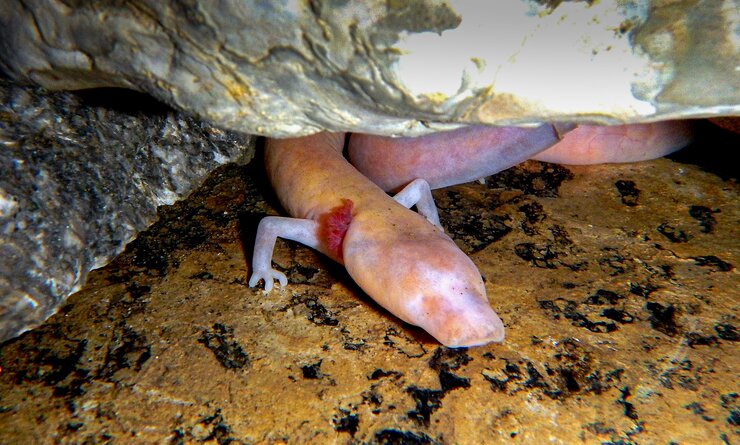Science
The goal of all caving groups is to find caves, protect and survey them. This is the basis for all further research work. Caves represent valuable archives from which a wide range of knowledge can be gained. For this purpose, speleologists cooperate with university researchers.
Die Grottenolme der Hermannshöhle
Seit 1931 werden in der Hermannshöhle in Rübeland (Stadt Oberharz am Brocken, Landkreis Harz, Sachsen-Anhalt) Grottenolme zu Schauzwecken gehalten. 1956 wurden weitere Grottenolme aus dem Schauteil der Adelsberger Grotte (Postojna) in die Hermannshöhle überführt. Trotz mehrfacher Versuche, die Tiere zur Fortpflanzung zu bringen, wurde dies 2016 erstmals beobachtet. Es handelt sich heute um das nördlichste Vorkommen dieser Art weltweit.
Infos zu Grottenolmen zusammengestellt von Uwe Fricke
Abschlussbericht zum Forschungsprojekt: Die Grottenolme der Hermannshöhle – faszinierende Bewohner der Dunkelheit ans Licht bringen

Resurgences as habitats
The Hesse Federation for Cave and Karst Research has been researching the resurgences in the Rhön Biosphere Reserve for many years. Sites are mapped, habitats and the zoological species are studied, and protection measures are proposed.
In terms of biospeleological recording, the Rhön is considered one of the leading regions in Europe: to date, 3841 springs have been recorded, 2,547 in Hesse, 718 in Thuringia and 576 in Bavaria. In 2021, over 150 new sites have been added.
Animals from springs are mostly small, inconspicuous and are often not detectable with naked eye. The determination of the finds is done with the help of about 90 experts from all over the world.
Depending on local conditions, the organisms are adapted to the flow of the outflowing water. Decisive for colonization is also the vegetation in the spring environment, as many organisms depend on certain introduced material such as fallen leaves or dead wood, on which biofilms (bacteria and fungi) settle as a grazing base.
More info:
https://rhoen.quellen-grundwasser.de/en/
SYMPOSIUM Wissenschaft unter Tage - Höhlenforschung im Dialog
Mittwoch, 15.06.2022
in Truckenthal, Landkreis Sonneberg, Südthüringen
Sience@Blessberghöhle
Stalagmites are among the most important climate archives (similar to lake and sea sediments or ice cores). As long as cave sediments and carbonate formations remain undisturbed, hydrological, climatic and environmental conditions can be reconstructed in detail. In the Bessberghöhle, groups of different scientific disciplines from 10 universities and research institutions are working together for this purpose.



